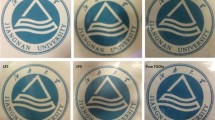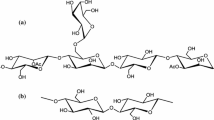Abstract
The gas barrier and mechanical properties are crucial parameters for packaging materials, and they are highly correlated to the molecular interactions in the polymer matrix. To improve these properties of TEMPO-oxidized cellulose nanofibers (TOCNs) composite films, we studied the effect using hydroxypropyl guar (HPG) or carboxymethyl guar (CMG) in the preparation of TOCN composite films, which were made by following the solution-casting method. The subsequent film characterizations were carried out by UV–Vis spectra, scanning electron microscopy, oxygen and water vapor permeability measurements, tensile and thermogravimetric analyses. SEM results showed that CMG-based films had denser structures than their HPG counterparts. Moreover, the improved hydrogen bonding of the CMG-based films was partially responsible for the improved gas barrier performance, tensile strength and thermal stability. These results support the conclusion that CMG had advantages over HPG when used in the preparation of TOCNs packaging composite films.








Similar content being viewed by others
References
Abdel-Halim ES, Al-Deyab SS (2014) Electrically conducting silver/guar gum/poly(acrylic acid) nanocomposite. Int J Biol Macromol 69:456–463
Benitez AJ, Torres-Rendon J, Poutanen M, Walther A (2013) Humidity and multiscale structure govern mechanical properties and deformation modes in films of native cellulose nanofibrils. Biomacromolecules 14(12):4497–4506
Cheng S, Zhang Y, Cha R, Yang J, Jiang X (2015) Water-soluble nanocrystalline cellulose films with highly transparent and oxygen barrier properties. Nanoscale 8(2):973–978
Dai L, Long Z, Lv Y, Peng Q-C (2014) The role of formic acid pretreatment in improving the carboxyl content of TEMPO-oxidized cellulose. Cell Chem Technol 48(5–6):469–475
Dai L, Wang B, Long Z, Chen L, Zhang D, Guo S (2015) Properties of hydroxypropyl guar/TEMPO-oxidized cellulose nanofibrils composite films. Cellulose 22(5):3117–3126
Das D, Ara T, Dutta S, Mukherjee A (2011) New water resistant biomaterial biocide film based on guar gum. Bioresour Technol 102(10):5878–5883
Deepa B, Abraham E, Cherian BM, Bismarck A, Blaker JJ, Pothan LA, Leao AL, de Souza SF, Kottaisamy M (2011) Structure, morphology and thermal characteristics of banana nano fibers obtained by steam explosion. Bioresour Technol 102(2):1988–1997
Fujisawa S, Okita Y, Fukuzumi H, Saito T, Isogai A (2011) Preparation and characterization of TEMPO-oxidized cellulose nanofibril films with free carboxyl groups. Carbohydr Polym 84(1):579–583
Fukuzumi H, Saito T, Iwata T, Kumamoto Y, Isogai A (2009) Transparent and high gas barrier films of cellulose nanofibers prepared by TEMPO-mediated oxidation. Biomacromolecules 10(1):162–165
Ghanbarzadeh B, Oleyaei SA, Almasi H (2015) Nanostructured materials utilized in biopolymer-based plastics for food packaging applications. Crit Rev Food Sci 55(12):1699–1723
Grzadka E (2013) Influence of surfactants on the adsorption and elektrokinetic properties of the system: guar gum/manganese dioxide. Cellulose 20(3):1313–1328
Grzadka E (2014) Stability of manganese dioxide by guar gum in the absence or presence of surfactants. Cellulose 21(3):1641–1654
Hosseinidoust Z, Alam MN, Sim G, Tufenkji N, van de Ven TGM (2015) Cellulose nanocrystals with tunable surface charge for nanomedicine. Nanoscale 7(40):16647–16657
Hu Z, Cranston ED, Ng R, Pelton R (2014) Tuning cellulose nanocrystal gelation with polysaccharides and surfactants. Langmuir 30(10):2684–2692
Klemm D, Kramer F, Moritz S, Lindstrom T, Ankerfors M, Gray D, Dorris A (2011) Nanocelluloses: a new family of nature-based materials. Angew Chem Int Ed 50(24):5438–5466
Kumar AP, Singh RP (2008) Biocomposites of cellulose reinforced starch: improvement of properties by photo-induced crosslinking. Bioresour Technol 99(18):8803–8809
Liu K, Nasrallah J, Chen L, Huang L, Ni Y (2015) Preparation of CNC-dispersed Fe3O4 nanoparticles and their application in conductive paper. Carbohydr Polym 126:175–178
Lucenius J, Parikka K, Osterberg M (2014) Nanocomposite films based on cellulose nanofibrils and water-soluble polysaccharides. React Funct Polym 85:167–174
Mao L, Law K, Claude D, Francois B (2008) Effects of carboxyl content on the characteristics of TMP long fibers. Ind Eng Chem Res 47(11):3809–3812
Mikkonen KS, Heikkila MI, Helen H, Hyvonen L, Tenkanen M (2010) Spruce galactoglucomannan films show promising barrier properties. Carbohydr Polym 79(4):1107–1112
Osterberg M, Vartiainen J, Lucenius J, Hippi U, Seppala J, Serimaa R, Laine J (2013) A fast method to produce strong NFC films as a platform for barrier and functional materials. ACS Appl Mater Interfaces 5(11):4640–4647
Pan Y, Xiao H, Song Z (2013) Hydrophobic modification of cellulose fibres by cationic-modified polyacrylate latex with core–shell structure. Cellulose 20(1):485–494
Rodionova G, Saito T, Lenes M, Eriksen Ø, Gregersen Ø, Fukuzumi H, Isogai A (2012) Mechanical and oxygen barrier properties of films prepared from fibrillated dispersions of TEMPO-oxidized Norway spruce and Eucalyptus pulps. Cellulose 19(3):705–711
Rosiaux Y, Muschert S, Chokshi R, Leclercq B, Siepmann F, Siepmann J (2013) Ethanol-resistant polymeric film coatings for controlled drug delivery. J Control Release 169(1–2):1–9
Saito T, Nishiyama Y, Putaux J-L, Vignon M, Isogai A (2006) Homogeneous suspensions of individualized microfibrils from TEMPO-catalyzed oxidation of native cellulose. Biomacromolecules 7(6):1687–1691
Saito T, Hirota M, Tamura N, Kimura S, Fukuzumi H, Heux L, Isogai A (2009) Individualization of nano-sized plant cellulose fibrils by direct surface carboxylation using TEMPO catalyst under neutral conditions. Biomacromolecules 10(7):1992–1996
Seantier B, Bendahou D, Bendahou A, Grohens Y, Kaddami H (2016) Multi-scale cellulose based new bio-aerogel composites with thermal super-insulating and tunable mechanical properties. Carbohydr Polym 138:335–348
Shah SWA, Jahangir M, Qaisar M, Khan SA, Mahmood T, Saeed M, Farid A, Liaquat M (2015) Storage stability of kinnow fruit (Citrus reticulata) as affected by CMC and guar gum-based silver nanoparticle coatings. Molecules 20(12):22645–22661
Sharma S, Zhang XD, Nair SS, Ragauskas A, Zhu JY, Deng YL (2014) Thermally enhanced high performance cellulose nano fibril barrier membranes. RSC Adv 4(85):45136–45142
Shimizu M, Fukuzumi H, Saito T, Isogai A (2013) Preparation and characterization of TEMPO-oxidized cellulose nanofibrils with ammonium carboxylate groups. Int J Biol Macromol 59:99–104
Shimizu M, Saito T, Isogai A (2016) Water-resistant and high oxygen-barrier nanocellulose films with interfibrillar cross-linkages formed through multivalent metal ions. J Membr Sci 500:1–7
Song J, Tang A, Liu T, Wang J (2013) Fast and continuous preparation of high polymerization degree cellulose nanofibrils and their three-dimensional macroporous scaffold fabrication. Nanoscale 5(6):2482–2490
Svagan AJ, Samir MASA, Berglund LA (2007) Biomimetic polysaccharide nanocomposites of high cellulose content and high toughness. Biomacromolecules 8(8):2556–2563
Way AE, Hsu L, Shanmuganathan K, Weder C, Rowan SJ (2012) pH-responsive cellulose nanocrystal gels and nanocomposites. ACS Macro Lett 1(8):1001–1006
Wen Y, Zhu X, Gauthier DE, An X, Cheng D, Ni Y, Yin L (2015) Development of poly(acrylic acid)/nanofibrillated cellulose superabsorbent composites by ultraviolet light induced polymerization. Cellulose 22(4):2499–2506
Woehl MA, Ono L, Riegel Vidotti IC, Wypych F, Schreiner WH, Sierakowski MR (2014) Bioactive nanocomposites of bacterial cellulose and natural hydrocolloids. J Mater Chem B 2(40):7034–7044
Wu C-N, Yang Q, Takeuchi M, Saito T, Isogai A (2014) Highly tough and transparent layered composites of nanocellulose and synthetic silicate. Nanoscale 6(1):392–399
Yang H, Tejado A, Alam N, Antal M, van de Ven TGM (2012) Films prepared from electrosterically stabilized nanocrystalline cellulose. Langmuir 28(20):7834–7842
Yano H, Sugiyama J, Nakagaito AN, Nogi M, Matsuura T, Hikita M, Handa K (2005) Optically transparent composites reinforced with networks of bacterial nanofibers. Adv Mater 17(2):153–155
Zhou W, Chen Z, Oshima N, Ito K, O’Rourke BE, Kuroda R, Suzuki R, Yanagishita H, Tsutsui T, Uedono A, Hayashizaki N (2012) In-situ characterization of free-volume holes in polymer thin films under controlled humidity conditions with an atmospheric positron probe microanalyzer. Appl Phys Lett 101(1):014102–014104
Acknowledgements
This study was financially supported by the National Natural Science Foundation of China (31270633), State Key Laboratory of Pulp and Paper Engineering (201512), Creative Fund of Combination of Industry, Academia and Research of Jiangsu Province, China-Prospective Joint Research Project (BY2013015-03) and Top-notch Academic Programs Project of Jiangsu Higher Education Institutions.
Author information
Authors and Affiliations
Corresponding author
Ethics declarations
Conflict of interest
All the coauthors of this work are included in this manuscript and they all endorse this submission. There are no conflicts of interest.
Rights and permissions
About this article
Cite this article
Dai, L., Long, Z., Zhao, Y. et al. Comparison of hydroxypropyl and carboxymethyl guar for the preparation of nanocellulose composite films. Cellulose 23, 2989–2999 (2016). https://doi.org/10.1007/s10570-016-0998-7
Received:
Accepted:
Published:
Issue Date:
DOI: https://doi.org/10.1007/s10570-016-0998-7




